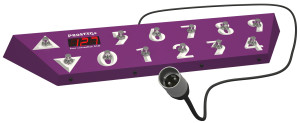Why using XLR Microphone cables for MIDI?
I did already retrofit MIDI foot controllers with XLR plugs in the 90′s. It requires just a few electronic components to send MIDI and phantom power over a single XLR microphone cable. But why did I do this? I have been touring with bands like Krokus and many others. For fast and reliable cabeling, I did need a solution that is road proof. XLR cables have many advantages over MIDI cables:
- Safe and reliable connection between the foot controller and the effect rack
- Extendable cord
- Locked plugs
- Spare cable available any time
- Power supply and MIDI signal over the microphone cable
MIDI cables are OK for use in the studio and for wiring inside the guitar rack, but in my opinion, they are not suitable for running on stage.
However, the MIDI communication is only unidirectional. This means, one unit talks (e.g. the foot controller) and the other is listening to it (e.g. the effects unit or the guitar amp). But what if you switch a channel on the amp itself and you like the MIDI foot controller’s state to change as well? That’s why we developed StageWire!
StageWire
StageWire is a consistent further development to send MIDI data over XLR cables. StageWire is a bus system. This means, every one talks to everyone. A Looper|Switcher can be interconnected with up to 14 MIDI foot controllers in daisy chain. Every unit can simultaneously talk and listen, all over a single microphone cable from device to device. Furthermore, the foot controllers are powered over the microphone cable! All units are in sync all the time. It does not matter on which unit you press a button.
StageWire was developed by Prostage and especially designed for rough use on stage. StageWire is four times faster than MIDI. Cable length may be up to 250m. Thus, you can send MIDI data over multicore-cables, e.g. to connect the FOH with the stage. The XLR connection guarantees, unlike the standard MIDI cables, a safe connection between foot controller and amplifier/effect rack. To connect StageWire with standard MIDI equipment, a MIDI XLR interface, such as the Prostage XTMpro, is required.
Well known manufacturers and rig builders such as Fractal Audio or Bob Bradshaw have applied this approach and now also build their foot controllers with 3-pin XLR connectors.








Hi Lukas! Great page!
Can I ask you a question?
Did yoy know which protocol of communication midi foot controller used to talk with his expanssion board? I have seen this feature in contoller such RST of CAE and SC1 of Skrydstrup.
I hope you can help me.
Thank you so much!
Cheers from Argentina!
This are proprietary protocols and I don’t think that there is anything compatible.